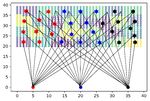Grid Integration of Renewables - InnoDC Project H2020
←
→
Page content transcription
If your browser does not render page correctly, please read the page content below
Grid Integration of Renewables InnoDC Project H2020 Marie Sklodowska-Curie funding European Union Horizon 2020 research & innovation KIC Master Course 20 October 2020 This project has received funding from the European Union's Horizon 2020 research and innovation programme under the Marie Sklodowska-Curie grant agreement no. 765585 This presentation reflects only the author’s view. The Research Executive Agency and European Commission are not responsible for any use that may be made of the information it contains.
Motivation United Nations’ Sustainable Development Goals Combating climate change and its impacts, Paris Agreement at COP21 Europe’s Energy Transition over the next 20-40 years Targets by 2020, 2030 and 2050 Increasing share of renewable energy resources in Europe, especially offshore wind energy Challenges in the operation of offshore grids and hybrid AC/DC systems Annual of offshore installations by country (left axis) and cumulative capacity(right axis)
Objectives ❑ To find innovative solutions to contribute to practical installation and operation of DC grids for offshore wind power ❑ To develop the most appropriate models and methods to study and manage future offshore grids and hybrid AC/DC systems ❑ Research outcomes are of direct use to the developers of (computational) tools and services ❑ To develop a pool of researchers in this in-demand field (offshore wind and DC grids) by providing them with both technical and personal and communication skills, innovative mind-set, entrepreneurship, and leadership and management skills ❑ Enhance the collaboration between EU universities and companies
InnoDC Project - Partners Start: 01/09/2017 End: 31/08/2021 6 x Countries - 15 x Partners University Beneficiaries: Cardiff University Universitat Universidad Do Porto Danmarks Katholieke Universiteit Tekniske Leuven Politècnica de Universitet Catalunya Non-academic Beneficiaries: CINERGIA, Spain EFACEC, Portugal Ecole Central de Lille ELIA, Belgium Partner organisations (training & secondments): Vattenfall Toshiba Friends of the Enersynt Belgium China Electric Power Red Eléctrica de España Supergrid Research Institute
Connection and integration ESR12: Stephen Hardy ESR2: Gayan Abeynayake ESR9: Jovana Dakic ESR11: Vaishally Bhardwaj
Cost Effective Solutions for Offshore Wind Transmission Stephen Hardy ESR 12 KU Leuven stephen.hardy@kuleuven.be
Problem Overview [1] How to find the Optimal HV Transmission Topology? [1] Supplementary material for “Assessing the Economic Value of Renewable Resource Complementarity for Power Systems: an ETSO-E study”. Radu et al.
Optimization Constraint Programming Problem Size Heuristics Inputs Outputs Optimality , Guarantee Candidate Transformers , s.t. Data Driven – M.L. , S0 θθ r L0 Route Finding Greedy Search S1 d Samples L1 α2 /2 ≥ 4 2 Error (e) α N 0.01 0.01 16513 Convex Optimization
HV Transmission Topology Optimization Radial Problem Meshed Problem Pre-Process Greedy Search Finalize Topology Size Reduction Size Reduction Route finding Optimal radial Constraints Algorithm A* Constraints Optimal meshed topology obtained via approximates obtained via and >1 export consisting of a M.L. filter relative layout M.L. filter cable radial single export possible considering possible radial Topologies cable is meshed Marine connections. obtained. obtained. connections. environment.
DC Collection Systems for Offshore Wind Collector Systems Gayan Abeynayake ESR 02 Cardiff University AbeynayakePA@Cardiff.ac.uk
Why DC collection systems • Lower collection system cable losses over MVac cables • Required only 2 cables to export power • Use of dcWTs could eliminate bulky 50/60 Hz power transformers • Increase power density of WTs with the increase of single WT capacity
Offshore Wind dc Collection Systems Shunt Topologies DC/DC power converter in the intermediate offshore platform to reduce cable losses (a) (b) (c) Dirk Van, Hertem, Gomis-Bellmunt Oriol, and Liang Jun. "Offshore Wind Power Plants (OWPPs)." In HVDC Grids:For Offshore and Supergrid of the Future, 528: Wiley-IEEE Press, 2016.
Key Research Questions • Identification of reliable dc collection systems from the pool candidates • Which converter topology is best suit for offshore dc collection platform in terms of reliability and cost • Impact of cable network reliability in reliability assessment of Offshore wind farms • Identification of suitable dcWT configuration based on physics-of- failure and mission profile
Offshore wind dc Collection systems Vdc Control Vac Control Medium freq. ac link DC Collection System Platform 2L MMC 3L-NPC MMC Vdc Control P Control – MPPT or P*
Reliability Methods dcWT Collection System Physics-of-failure based PE devices Collection Platform reliability analysis with different mission Time-homogenous profiles Markov Chain models Reliability Block Diagram(RBD) based analysis
Tools for techno-economic analysis of transmission systems for offshore wind power plants Jovana Dakic ESR 9 UPC jovana.dakic@upc.edu
Objectives Development of a tool for technical and economic comparison analysis of the different transmission systems including all aspects as technology, efficiency, reliability and availability of components Source: Worley https://www.worley.com/what-we-do/our-markets/new-energy/wind
HVAC vs HVDC Well known technology Reactive power compensation Limited transferred power Long distances Cost DC breakers
Low-frequency technology Lower charging current and Core of transformer is bigger reactive power Cost of B2B converter Possibility of using AC breakers
Defining initial parameters Optimization of the system OWPP rated power Minimizing power losses and Transmission distance cost of components while Grid parameters complying with operational limits and calculation of total cost Optimal configuration Comparison of all systems and selection of the optimal one Modelling of the systems Obtaining detailed parameters of the components and its cost functions
Reliable operation of hybrid AC/DC power systems in different time frames under uncertainty Vaishally Bhardwaj ESR 11 KU Leuven vaishally.bhardwaj@kuleuven.be
Current practices in Reliability management ➢ Present reliability assessment based on deterministic N-1 criterion ➢ Fixed set of most credible N-1 contingencies with equal probability ➢ Time frames - from year(s)-ahead up to real-time operation ▪ Reliable grid operation → Short-term time frames ➢ Reliable operation – System operator managing sequence of decisions under uncertainty ▪ Unplanned generation and load variations, market factors ➢ Current approaches ▪ Preventive security ▪ Preventive-corrective security Source: Van Hertem, D., Gomis-Bellmunt, O., Liang, J.,"HVDC Grids For ➢ Preventive-corrective : allows for preventive and post- Offshore and Supergrid of the Future", Wiley IEEE Press, February 2016 contingency corrective actions 24
Challenges in reliable operation Day ahead generation forecast & actual wind as per TenneT TSO, Germany for 9th-10th October 2020 • Likelihood and impact of contingency not considered, interdependencies ignored Shortcomings • No economic consideration of corrective actions of N-1 criterion • May lead to cases of higher operational costs/ higher risks Actual = 8843 MW Greater Forecast = 6944 MW • Escalation in system uncertainties integration of • Consider additional contingencies e.g. also for RES, smart grids unpredictable injections from RES and intra-day • Equal probabilities, static list of contingencies not markets optimal → Probabilistic/ Risk-based reliability criteria ! 25
HVDC in reliable operation ➢ Flexibility from AC/DC converter (active as well as reactive power) can be utilized as control action for reliable operation ▪ Control transmission capacity between zones ▪ Congestion Management ▪ Converter redispatch can be utilized as a preventive measure ▪ Faster corrective control after contingency in real-time (owing to smaller time-constants) ▪ Economical than re-dispatch, load curtailment Source: Van Hertem, D., Gomis-Bellmunt, O., Liang, J., "HVDC Grids For Offshore and Supergrid of the Future", Wiley IEEE Press, February 2016 26
Framework for reliable AC/DC grid operation ➢ Implementation of preventive and preventive-corrective security-constrained optimal power flow (SCOPF) models for hybrid AC/DC systems (a) Preventive SCOPF model for AC/DC system (b) Preventive-corrective (P-C) SCOPF model for (c) Preventive-short-term-corrective (P-ST-C) SCOPF AC/DC system model (single time instant) for AC/DC system ➢ Comparison of purely preventive and preventive-corrective security approaches ➢ Analyze the impact of contingency probability and the generator corrective cost coefficient on total risk and trade-off between preventive actions cost and corrective actions risk ➢ Evaluate flexibility offered by fast dynamics of AC/DC converters after a contingency 27
Framework for reliable AC/DC grid operation ➢ AC/DC grid security-based optimization: large-scale non-linear non-convex optimization problem ➢ Convex relaxations for lesser computational burden, global optimum ➢ Extension of current AC/DC SCOPF model to multiple time frames ➢ Based on dynamic receding horizon approach ➢ Consideration of generation, load uncertainties into the AC/DC SCOPF model 28
You can also read



























































